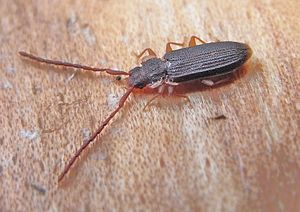Long-horned predatory flat beetle
| Long-horned predatory flat beetle | ||||||||||||
|---|---|---|---|---|---|---|---|---|---|---|---|---|

Long-horned predatory flat beetle |
||||||||||||
| Systematics | ||||||||||||
|
||||||||||||
| Scientific name | ||||||||||||
| Uleiota planata | ||||||||||||
| ( Linnaeus , 1761) |
 Fig. 1: Female head and pronotum , upper jaw without horn Fig. 2: Underside  |
 Fig. 3: Head of a male from Reitter , Fauna Germanica Fig. 4: Detail of wing cover in the area of the hind leg A wing cover seam B shoulder rib C rear rail  |
 Fig. 5: Mating, male left Fig. 6: According to Reitter A pupa B larva Fig. 7: Mouth parts according to Reitter A Upper lip B Upper jaw (male) C Lower lip with lip probe D Lower jaw with jaw probe   |
The long-horned flat beetle , also long-horned flat beetle and obsolete long-horned flat beetle ( Uleiota planata ), is a beetle from the family of flat beetles . The part of the name "long-horned" refers to the long antennae that were previously called horns. The discrepancy between flat beetles and flat beetles is explained by the fact that Uleiota planata was previously assigned to the flat beetle family (Cucujidae), but is now part of the new flat beetle family (Silvanidae). The scientific generic name "Uleiota" means old Gr. :, ὑλειώτης, hyleiōtes , "the one who lives in the forest". The specific epithet "planata" alludes to the flat shape of the beetle ( lat. Planatus "flattened"). The widespread beetle lives under the peeling bark of various deciduous and coniferous trees .
Characteristics of the beetle
The beetle has a very flat, elongated, black-brown body with a rough surface. Young specimens can be light yellow ocher. The length is pretty much constant at five millimeters.
The mouthparts point forward. The upper lip is rounded in front and finely ciliate (Fig. 7 A). The upper jaw ends with two teeth , the inner edge is lined with skin and the base has a finely grooved grinding surface. The upper jaws of the males have a horn curved upwards and forwards (Fig. 7 B, horn on the left, and Fig. 3). The jaws are four-ply and the end phalanx gradually pointed (Fig. 7 D right). The end link of the three-part lip stylus is cut off at an angle towards the tip (Fig. 7 C right).
The eleven-limbed filiform antennae are remarkably long and hairy. They are about body length. The first link is long and strong, the second small and delicate, the following ones slender and all of the same thickness and about the same length (links 1 to 3 in Fig. 1).
The pronotum is wider than it is long, wider in front than the head and steadily narrowing towards the base. It is finely serrated on the sides, the anterior angles are drawn out in a two- to three-fold serrated flap (Fig. 1).
The elytra are parallel. A rib with a sharp ridge emerges on each of the shoulders (Fig. 4 B), which runs parallel to the edge and only disappears shortly before the wing tip. Between this rib and a flat rib parallel to the seam , the elytra are slightly depressed and lightly striped, the strips are dotted and provided with bristle hairs (Fig. 4).
The tarsi are all five-limbed, but the fourth limb is very small and can easily be overlooked. The claw link is large, about as long as the rest of the tarsal links together. The legs are pale yellow, which is why the species was sometimes also called Uleiota flavipes ( Latin flavipes "light-legged"). The front and middle hips are spaced apart, small and spherical (Fig. 2). On the abdomen, five segments of roughly the same length can be seen that have not grown together.
biology
Larvae (Fig. 6 B) and adults live under the bark of many deciduous tree species and some conifers , especially pines . The adults are usually found in groups. However, adults can also be found on the bark.
The larvae feed on saps and excrement of other insects living under the bark, the adults hunt insects under loose bark and also eat mushrooms.
A study on beeches found that the frequency of the species, depending on the decomposition status of the wood, is very constant compared to species in the same habitat. In comparison to species with the same habitat, the larvae are relatively heat-resistant; in the experiment they survived a three-hour stay at 10 percent humidity and 54 degrees Celsius.
In the mating position, the bodies form an angle of 180 ° and the ends of the abdomen touch each other (Fig. 5).
distribution
Because of its way of life, the beetle can be easily abducted. The species is native to England via southern Scandinavia to the Caucasus and Iran as well as to the Mediterranean countries of Spain , Greece and Italy , and also to Portugal . He is missing in Sicily and Crete .
literature
- Heinz joy, Karl Wilhelm Harde, Gustav Adolf Lohse (ed.): The beetles of Central Europe . tape 7 . Clavicornia. Spektrum Akademischer Verlag, Munich 1967, ISBN 3-8274-0681-1 .
- Gustav Jäger (Ed.): CG Calwer’s Käferbuch . K. Thienemanns, Stuttgart 1876, 3rd edition
- Edmund Reitter : Fauna Germanica, the beetles of the German Empire III. Volume, KGLutz 'publishing house, Stuttgart 1911
Individual evidence
- ↑ a b Uleiota planata at Fauna Europaea. Retrieved January 22, 2011
- ↑ "Explanation of the scientific beetle names"
- ^ M le Chevalier de Lamarck: Histoire naturelle des animaux sans vertebrates Paris Mars 1817
- ↑ Polish coleopterologist website with a description of the species
- ↑ Wolfgang Willner: Taschenlexikon der Käfer Mitteleuropas . 1st edition. Quelle & Meyer, Wiebelsheim 2013, ISBN 978-3-494-01451-7 .
- ↑ a b Roger Dajoz: Entomologia forestal: Los insectos y el bosque Ediciones Mundi-Prensa 1999 ISBN 84-7114-871-4